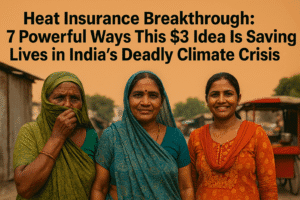The Ahmedabad rubbish dump at 8 AM is already a vision of hell. Laxmiben Nadia, 57, drapes her sari over her face, a flimsy shield against the stench and the relentless Gujarat sun. She’s one of 50,000 waste pickers scouring this 6-mile wasteland, salvaging scraps of plastic and metal to sell for a few dollars a day. Last summer, the heat won. Sweating profusely, she collapsed mid-shift, struck by temporary paralysis. “I laid there 20 minutes, unable to move,” she recalls.
For Nadia and millions of India’s informal workers – street vendors, ragpickers, day laborers – a day missed is a day hungry. Choosing between health and income is a brutal calculus during India’s escalating heat crises, where temperatures now regularly shatter 110°F (43.3°C) and beyond, causing thousands of heatstrokes and deaths annually.
But Nadia’s story took an unprecedented turn. While recovering for a week, she received $14. It wasn’t charity or disaster relief. It was an insurance payout, triggered automatically because the temperature had crossed a specific threshold for two consecutive days. For the first time, staying home to survive didn’t mean her family starved.
This is Parametric Heat Insurance – a lifeline woven from data and dignity.
How It Works (Simply):
- The Trigger: Experts set local temperature thresholds based on dangerous heat levels (e.g., 110.5°F/43.6°C for 2 days in Ahmedabad).
- The Enrollment: Informal workers, primarily women organized through the massive Self Employed Women’s Association (SEWA), pay a small, subsidized annual premium (around $3.50).
- The Payout: When the local weather station records the trigger temperature, every enrolled member in that area automatically receives a fixed cash payment (e.g., $8-$15) within weeks. No claims forms. No proving illness. Just cash.
The Magic is in the “Parametric” Part: Unlike traditional insurance demanding proof of loss, this model pays based solely on the measurable event – the extreme temperature. It cuts through bureaucracy, reaching vulnerable people quickly.
The Human Impact:
- Laxmiben Nadia (Waste Picker): Her $14 payout wasn’t just recovery money. It was seed capital. She bought eggs and bread, setting up a small evening food cart. “It helped me manage… when I needed to rest,” she says, her relief palpable. The payout provided agency.
- Shobha Ben Bimabhai (Street Vendor): For 30 years, Shobha stood for hours under the sun selling home decor from her pushcart. Customers vanished in extreme heat, but closing meant no income. Last summer, the insurance payout allowed her, for the first time, to close for two days without fear. She used the money for her daughter’s school fees and books. “I never thought insurance could be for someone like me,” she reflects.
The Engine Behind It: SEWA, a trade union representing over 3 million informal women workers, partnered with the non-profit Climate Resilience for All. Together, they co-fund the premiums (workers pay part, the NGO covers the rest), negotiate with insurers (ICICI Lombard locally, Swiss Re for reinsurance), and manage the complex logistics of enrolling members and distributing payouts across vast, often remote areas. In 2024 alone, the program disbursed over $350,000 to 50,000 women.
Why This Matters More Than Ever:
- Climate Reality: India’s heatwaves are intensifying due to climate change. Traditional coping mechanisms are failing. Workers need options to stay safe without destitution.
- Dignity, Not Debt: Previously, missed work often forced workers into predatory loans. This insurance prevents that cycle of exploitation. “It ensures women lead a life with dignity,” emphasizes Anisha Baghban, SEWA Secretary.
- Scalable Innovation: Parametric models are proving effective globally for climate risks (e.g., cyclones in the Pacific, floods in Nagaland, India). This heat insurance pilot demonstrates its power specifically for urban informal workers facing rising temperatures.
- Beyond Health: While health is the immediate driver, the payout’s flexibility is key. Workers use it for medical costs, essential bills, children’s needs, or even micro-investments like Nadia’s food cart – building resilience against the next crisis.
The Road Ahead: While transformative, experts like climate scientist Akshay Deoras stress this insurance cannot be the sole solution. It must be coupled with essential risk reduction: accessible shade, clean drinking water, robust early warning systems, and ultimately, government action on climate mitigation.
SEWA’s ambition is clear: take this proven model to the state and national government. Scaling to protect millions more vulnerable workers demands public investment and policy integration. “The challenge now is scaling… it will be difficult without government support,” acknowledges Baghban.
The Core Insight: The genius of this insurance isn’t just the financial safety net. It’s the profound restoration of choice to those who’ve never had it. For Laxmiben, Shobha, and thousands like them, a predetermined temperature reading translates directly into the power to say: “Today, I choose to stay alive.” In the furnace of climate change, that choice is priceless. This simple, data-driven idea offers a blueprint for resilience where human vulnerability meets planetary extremes.

You must be logged in to post a comment.